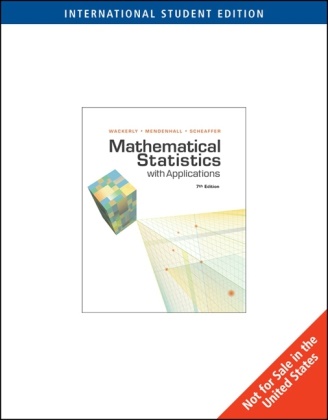Read more
Informationen zum Autor The late Dr. Mendenhall served in the Navy in the Korean War and obtained a Ph.D. in Statistics at North Carolina State University. After receiving his Ph.D , he was a professor in the Mathematics Department at Bucknell University in Pennsylvania before moving to Gainesville in 1963 where he was the first chairman of the Department of Statistics at the University of Florida. Dr. Mendenhall published articles in some of the top statistics journals, such as Biometika and Technometrics; however, he is more widely known for his prolific textbook career. He authored or co-authored approximately 13 Statistics textbooks and several books about his childhood. Richard L. Scheaffer, Professor Emeritus of Statistics, University of Florida, received his Ph.D. in statistics from Florida State University. Accompanying a career of teaching, research and administration, Dr. Scheaffer has led efforts on the improvement of statistics education throughout the school and college curriculum. Co-author of five textbooks, he was one of the developers of the Quantitative Literacy Project that formed the basis of the data analysis strand in the curriculum standards of the National Council of Teachers of Mathematics. He also led the task force that developed the AP Statistics Program, for which he served as Chief Faculty Consultant. Dr. Scheaffer is a Fellow and past president of the American Statistical Association, a past chair of the Conference Board of the Mathematical Sciences, and an advisor on numerous statistics education projects. Klappentext Seventh edition. A solid foundation in statistical theory! with practical applications. Zusammenfassung In their bestselling MATHEMATICAL STATISTICS WITH APPLICATIONS! premiere authors Dennis Wackerly! William Mendenhall! and Richard L. Scheaffer present a solid foundation in statistical theory while conveying the relevance and importance of the theory in solving practical problems in the real world. The authors' use of practical applications and excellent exercises helps you discover the nature of statistics and understand its essential role in scientific research. Inhaltsverzeichnis 1. What Is Statistics?Introduction. Characterizing a Set of Measurements: Graphical Methods. Characterizing a Set of Measurements: Numerical Methods. How Inferences Are Made. Theory and Reality. Summary. 2. Probability. Introduction. Probability and Inference. A Review of Set Notation. A Probabilistic Model for an Experiment: The Discrete Case. Calculating the Probability of an Event: The Sample-Point Method. Tools for Counting Sample Points. Conditional Probability and the Independence of Events. Two Laws of Probability. Calculating the Probability of an Event: The Event-Composition Methods. The Law of Total Probability and Bayes''''s Rule. Numerical Events and Random Variables. Random Sampling. Summary. 3. Discrete Random Variables and Their Probability Distributions. Basic Definition. The Probability Distribution for Discrete Random Variable. The Expected Value of Random Variable or a Function of Random Variable. The Binomial Probability Distribution. The Geometric Probability Distribution. The Negative Binomial Probability Distribution (Optional). The Hypergeometric Probability Distribution. Moments and Moment-Generating Functions. Probability-Generating Functions (Optional). Tchebysheff''''s Theorem. Summary. 4. Continuous Random Variables and Their Probability Distributions. Introduction. The Probability Distribution for Continuous Random Variable. The Expected Value for Continuous Random Variable. The Uniform Probability Distribution. The Normal Probability Distribution. The Gamma Probability Distribution. The Beta Probability Distribution. Some General Comments. Other Expected Values. Tchebysheff''''s Theorem. Expectations of Discontinuous Functions and Mixed Probability Distributions (Optional). Summary. 5. Multivariate Pro...

